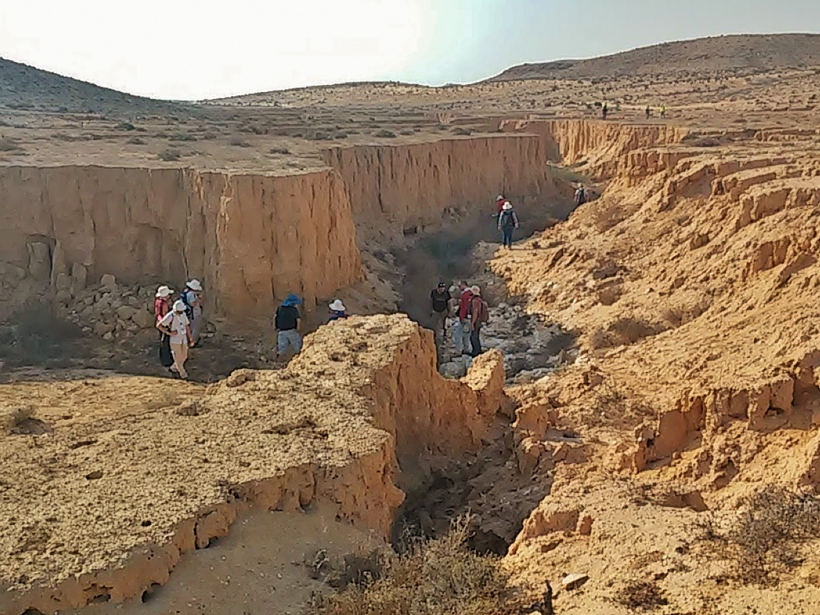Mineral dust’s primary roles in forming soils, supplying nutrients to the oceans, and modifying regional climate and environment have been known and studied for decades. Terrestrial, marine, and lacustrine (lake) archives of dust provide information about processes and episodes of dust grain production, dust sources and transport, and climate.
The dust scientific community is traditionally divided into two main groups: Climatologists, atmospheric modelers, oceanographers, and geochemists mostly study atmospheric dust, which is composed of clay and fine-silt grains and transported across hundreds to thousands of kilometers. On the other hand, geomorphologists, Quaternary geologists, and pedologists (soil scientists) study the entire range of dust grains but often focus on coarse dust—composed of medium- to coarse-silt grains, transported across limited distances, and commonly forming thick loessial deposits. Despite years of research on atmospheric dust and dust deposits, the interaction between and within these two groups is limited, and this hinders the advancement of knowledge and understanding about the dust cycle.
We brought together geologists, geomorphologists, pedologists, geochemists, archaeologists, modelers, and climate experts to discuss dust, dust deposits, and soil development in arid and semiarid regions.
To bridge this gap, we brought together an interdisciplinary group of geologists, geomorphologists, pedologists, geochemists, archaeologists, modelers, and climate experts for a 5-day seminar and field trip to discuss recent advances and challenges in the disciplines of dust, dust deposits, and soil development in arid and semiarid regions. The seminar was part of the AEOMED project (Loess and Aeolian Additions to Current Surface Soils and Paleosols in Mediterranean Climate), under the International Union for Quaternary Research (INQUA) commission on Terrestrial Processes, Deposits, and History (TERPRO).
The field trip to the Negev desert offered diversity in dust deposits and climate over a very short distance of tens of kilometers. This diversity provides a “natural laboratory” for examining spatial and temporal variability in the processes responsible for loess deposition and soil formation in the past along a transect from the proximal source of the loess (sand dunes) to different sinks located downwind.
Fifty-nine scientists from 10 different countries attended the seminar. Presentations over the course of 2 days addressed recent advances in our understanding of the following topics:
- dust generation and emission
- dust transport and deposition in and around the Mediterranean (North Africa and Europe)
- dust sources and deposits in the United States
- dust deposits and soils
- dust provenance
- loess in Italy’s Po Plain and comparison to other Mediterranean regions
During the 3 days of the field trip, we visited key loess sequences in the core and edges of the Negev loess and discussed identification, chronology, characteristics, and sources of the desert’s primary loess (the field trip guide book is available online). We visited the fringe of the northwestern Negev dune field, where silt grains are generated from sand, and we visited well-dated, fluvially and colluvially reworked loess sequences documenting late Pleistocene fluvial activity (starting about 70,000 years ago). We examined prehistoric sites associated with aeolian (wind-borne) deposits, drove along the incense route and visited ancient Nabatean cities, observed the operation of a large portable wind tunnel, and visited exposures of lacustrine Dead Sea basin sediments partially composed of primary and secondary dust/loess.
The field trip stimulated discussions about the basic formation of silt grains in deserts, identification of loess and dust sources, transport of dust particles, and the accretion of dust deposits and formation of cumulic (accumulating) soils within them under different climatic regimes during the late Quaternary (mainly over the past 180,000 years). The group stressed the importance of interdisciplinary research and field experience to advancing our understanding of the dust cycle.
We encourage climatologists and atmospheric scientists to become involved in field-based research.
Following the learning experience of the diverse group of scientists participating in the field trip, we encourage climatologists and atmospheric scientists to become involved in field-based research. This involvement will help them acquire a sense of the quality of records involved and in turn will improve the interpretations of these records by Quaternary geologists.
—Onn Crouvi and Rivka Amit, Geological Survey of Israel, Jerusalem, Israel; email: [email protected]; and Yehouda Enzel, The Hebrew University of Jerusalem, Jerusalem, Israel
Citation: Crouvi, O., R. Amit, and Y. Enzel (2016), Seeking knowledge in the dust, Eos, 97, doi:10.1029/2016EO049501. Published on 8 April 2016.
Text © 2016. The authors. CC BY-NC 3.0
Except where otherwise noted, images are subject to copyright. Any reuse without express permission from the copyright owner is prohibited.

